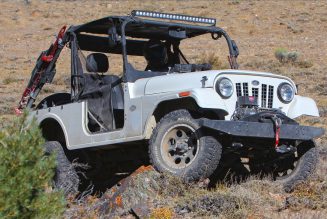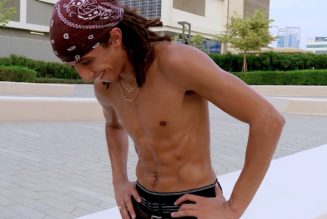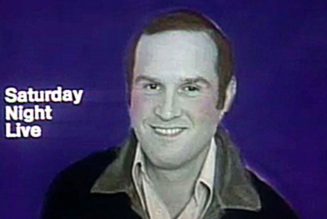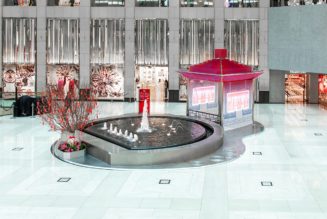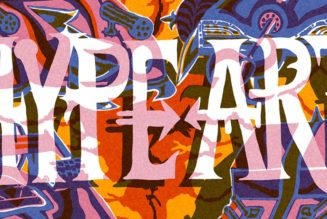It is a simple formula really: Take a common American pickup truck, stuff in more power than it deserves, and have fun. Between the Roadkill and Roadkill Garage shows, we have assembled a triple play of fast haulers, appropriately identified as the original (Chevy) “Muscle Truck” the “Mopar Muscle Truck” (MMT) and the “Ford Muscle Truck” (FMT).
These trucks quickly became fan favorites as a group and individually, and continue to appear in Roadkill related content and at Roadkill events. The common thread is that all are short-bed stepsides from the late 60’s to early 1970s, built for street performance and all-around vehicular mayhem. Aside of their similarities, each of these muscle trucks has its own personality with distinct differences. Each has a different story to tell, and here they are.
The Original “Muscle Truck”
Starting it all is the 1974 Chevy C-10 long referred to as simply the “Muscle Truck,” but lately we added “Original” to distinguish it from the others. This truck was around well before the Roadkill Show, built by Freiburger and Chad Reynolds in a very Roadkill-like 15-day thrash to make it to the GM Performance Parts LSx Shootout way back in 2008. Freiburger already had the truck, bought from a Craiglist ad for $1,500 as an unassembled project, complete with multi-colored body panels from several donor vehicles. The plus here was the blasted and powdercoated chassis and suspension. To make it a candidate for the LSx Shootout, Freiburger also had a modified GM Performance Parts LS6 crate engine left over from dyno testing for Hot Rod magazine. Combining this truck and engine gave birth to what became the Roadkill muscle truck.
The object was low, loud and mean, with modern power via the modified late model LS6 engine. The LS6 was originally the higher-power version of GM’s aluminum LS1 engine found in the Z06 C5 Corvette, and offered as a crate engine from GM with a factory rating of 405 horsepower. Freiburger modified this one with a hotter Crane cam (228/232-degrees duration @ 0.050; 0.600-inch lift) and Crane roller rockers. It an MSD engine management system and ignition, along with a BBK aluminum EFI intake manifold. Freiburger conservatively estimates the output at 475 horsepower. As installed in the truck, the engine’s screaming exhaust note has become famous, but it was actually a fluke – the last minute result of using whatever parts were at hand when the truck was originally built. Included here were mid-length headers, separated dual three-inch pipes stepped-up to meet 4-inch Dynomax Race Bullet mufflers, all terminating with downturns in front of the rear axle. The combination resulted in a shrill shriek that made driving it great and painful at the same time.
The engine is mated to a full manual valve body Dynamic Racing Transmission’s Turbo 400 automatic trans equipped with a Gear Vendor over/underdrive unit. A 4000 rpm stall Art Carr torque converter is sandwiched in-between the engine and trans. You’ll find a Ford 9-inch rear end salvaged from an F100 perched over the springs, and though it was originally fitted with a spool and 5.13:1 gears, it was re-geared on Roadkill Garage episode 6 with more drivable 3.73:1 gears and a Detroit Locker differential. In that same episode we made other concessions to luxury, adding insulation, carpeting in the cab, a new Pioneer stereo, rear view mirrors, and we finally got the inoperable rear brakes functional. Although these changes might seem to make the truck milder, the violent, shrieking, long-distance burnout ability remains intact.
An overview of the Muscle Truck would not be complete without a description of the suspension and the resulting low-down stance. Originally the truck was equipped with an Air Ride suspension system up front for a total on-the-dirt slam. For simplicity, that setup was recently replaced with coil springs, with CCP lower and Ride Tech upper control arms. The rear has always been leaf springs with Cal Tracs bars for on the track bite. Lowering at the rear is via the previously mentioned axle flip, which works with a “Z” sectioned frame rail for clearance. The whole mess rides on 17×8-inch Cragar Soft 8 wheels at all four corners, running 225 55r-17 front rubber and 31-inch tall 285 60r-17 tires in the back.
The original Muscle Truck is by far the most well-known of our trio of trucks. We haven’t counted them, but we suspect this truck has appeared in more MotorTrend shows than any of our other vehicles. Actually, its video glory began before MotorTrend videos were even a thing. What’s next? It is really pretty good the way it is now, but don’t be surprised to see it appear in a future show for who-knows-what mods and hijinks.
| Vehicle | 1974 Chevrolet C10 |
| Original Purchase Price/Source | $1,500 Craigslist buy |
| Engine | LS6 Modified by Freiburger |
| Power | 475 |
| Transmission | Dynamic Racing TransmissionTurbo 400 with Gear Vendor |
| Rear and Gear | 9-Inch Ford; 3.73:1 ratio |
| Wheels | Cragar Soft 8’s 17×8 |
| Tires | Front: 225 55r-17; Rear: 285 60r-17 |
| Coolest Feature | Exhaust Note |
| What Sucks | Unnecessarily radical rear frame Z-notch |
The warmed-over LS6 engine under the hood is just a buzz-saw, ripping rpm and making power with ease. Better still, the reliability is amazing – nothing breaks or leaks, and it never lets us down.
The multi-color exterior look was not by design – it’s because this truck’s body was pieced together using salvaged and replacement panels from different sources.
A little bit of a revamp happened to the interior recently, including sound-deadening, carpeting, and new stereo. The brutal B&M ProShifter and stylish OEM Buick GS steering wheel have been there since the beginning.
While the other “muscle trucks” sit high on stock suspension, the original MT hunkers down thanks to custom front a-arms holding 2-inch drop spindles and lowering springs up front, and an axle-over-spring setup at the rear.
Mopar Muscle Truck (MMT)
My 1974 D100 Mopar Muscle Truck made its debut in episode 15 of Roadkill Garage, where this nearly completed project truck finally hit the road. The backstory on this one actually involves the tale of three similar Dodge trucks, beginning with the Bronze 1977 D100 stepside featured in Roadkill episode 40. I’ve owned that truck since the mid 1990s, and it has been in fairly continuous use since. The drawback to that one is the model year. In California, anything newer than 1975 requires biannual smog inspection, making modification a difficult if not illegal pursuit. Enter the white 1972 D100 fleetside shortbed seen in the background of many episodes of Roadkill Garage and Roadkill Extra. That was built as a replacement for the original 1977 step side solely for it smog exempt status. When a hit and run incident damaged the ’72 fleet, the hunt was on for replacement parts to fix it. That led to the U-Pull Parts yard in Bakersfield, California, where the 1974 D100 stepside now known as the Mopar Muscle Truck was found.
Up on blocks in the salvage yard, the MMT already gave up plenty of parts inside and out. Despite that, a few laps around it showed a real jewel in the rough. The factory paint was remarkably good, the body panels were straight, and the entire truck was amazingly rust free. It didn’t take long to realize that this was a much nicer truck than the ’72 fleetside I was looking to fix. The fact that it was a factory manual shift truck sealed the deal. Some negotiation with the yard had it bought for $900 and it was saved from the crusher.
To provide the pieces to fix all of these trucks, yet another one was acquired just as a parts truck—the black 1975 D100 that was featured as the stripped-out Truck Buggy in episode 3 of Roadkill Garage. That one came in trade for a set of cylinder heads, complete but un-registerable with massive DMV back fees and an ancient bank lien. Many of the parts for the MMT came from this parts truck, including the mint front bumper and grill, radiator, fan shroud, power steering, cowl panel, and an untold number of small parts.
Inside the MMT, virtually nothing was salvageable except the odd split-back bench seat for use as a core. The cab was stripped to the bare firewall, insulated, carpeted, and the entire dash, instrument panel, wiring, and a factory A/C system were all built from nice used and wrecking yard pieces. The great thing about this era of Dodge truck is that parts are still cheap and plentiful at the junkyard, but we don’t expect that to last. The seat was sent in to a local shop for new upholstery in a very un-Roadkill-like move, but hey, it is a Roadkill Garage project. We have our own rules. Inside the MMT really is “mint.”
Under the hood, the 318 engine the truck came with was pulled and replaced with a 360 Mopar small block, I built a few years ago for a feature in the now-defunct Engine Masters magazine. With 10.75:1 compression, a custom Comp solid flat tappet cam, and wild cylinder head and intake manifold porting, the 360 delivered 520 horsepower on the engine dyno. I installed it with Summit long-tube headers leading to a fabricated 3-inch side-hung exhaust using Hooker Aero-Chamber mufflers.
The rest of the drivetrain was assembled from used, salvaged, or fabricated parts. First, the floor-shifted 3-speed manual transmission that came with the truck was replaced with a junkyard A-833 4-speed overdrive trans using a car bellhousing, a used Centerforce clutch, modified OE clutch linkage, and a used OEM Hurst shifter. Overall, the transmission set-up was cheap, but proved to be not so good. The MMT’s factory 8 ¼ rear originally just got a welded differential as shown in RKG episode 15, but later was replaced by the 8 ¾ from the laid-up 1972 fleetside truck, complete with a 3.55:1 ratio limited-slip differential. Wheels are salvaged old-school slots that were polished and clear-coated; 15×7 front, and 15×10 rear, with 255 60R-15 and 275 60R-15 tires.
Disaster struck when the 360 engine developed a pinhole coolant leak in cylinder number 3 during the filming of Roadkill Garage episode 20. A hot 318 was swapped in as a stop-gap as featured in Roadkill Extra episode 240, but later changed in Roadkill Garage Episode 21 to the hottest engine yet, a 408 Magnum with 550 horsepower. In that episode the MMT was taken to the track for a shake-down and promptly proved to have an unshiftable trans, an unstable suspension, and then the differential blew. The MMT is really good, but needs to be perfected – maybe in a future episode.
| Vehicle | 1974 Dodge D100 Utiline |
| Original Purchase Price/Source | $900 at U-Pull Parts Bakersfield CA |
| Engine | 408 Mopar Stroker Built By Dulcich |
| Power | 550hp/550tq |
| Transmission | A833OD Manual |
| Rear and Gear | Mopar 8 ¾; 3.55:1 Ratio |
| Wheels | Re-polished Junkyard Slots; 15x7F 15x10R |
| Tires | 255r60-15F; 275r60-15R |
| Coolest Feature | Clutch Pedal |
| What Sucks | Doesn’t power shift and won’t go down the track without killing you. |
One of the goals in the MMT build was a totally nice interior that retains the factory vibe. Everything inside but the seat upholstery and carpet was built with mint used parts, mostly from junkyard trucks. The instrument panel is the later wraparound style; the metal door panels are usually only found on fleet or early low-line trucks; the factory air system, a/c dash, and controls were all added.
Outside, the factory paint is not perfect, but still shines. The bumper and grill are nice used pieces from a parts truck to replace the originals. Salvaged slot mags set-off the old school look, and were dirt cheap. The large OEM flag style mirrors remain as a nod to 1970’s utility and function.
Under the hood is a 408 stroker based on a 5.9 Magnum engine. Big valves, expert porting of the heads and intake, a stout custom hydraulic roller comp cam, and nearly 11:1 compression give 550 horsepower as dyno tested.
I custom fabbed the rear bumper from a piece of 4x6x0.125 mild steel tubing, following the lower bed contour, and recessing the plate. Work lights are operated by a toggle switch in the dash. The tailgate was bent during the trucks brief stay at the salvage yard, but I found a perfect used one that will eventually replace it.
Ford Muscle Truck (FMT)
The hunt was on to find a Ford truck to complete our collection of muscle trucks from the big three domestic manufacturers, and for a cool build show for a Roadkill Garage episode. To keep the common theme, it had to be a shortbed stepside regular cab. We love the mid ’50s Ford trucks, but they cost mega bucks, and don’t really fit in with the others. We also considered the earlier ’60s trucks which are cool, but decided the 1967-1972 Ford “bumpside” had the style, while this same chassis was the basis for the later, very similar, 1973-79 “dentside” trucks. We found that only single digit percentages of Ford truck production over these years featured the stepside (Ford technically called “flareside”) bed, making them pretty rare. We also found that these trucks have already become sought after and therefore they are already expensive.
I found a Skyview Blue 1968 stepside that looked the part. It already had the bones of a muscle truck, with a swapped in 460 big-block Ford and C6 transmission, a B&M ratchet shifter, and best of all, it looked solid. At an asking price of $4,500, it was definitely outside our normal price range, but looking at the prices these trucks go for, it was actually a bargain—especially with the big-block Ford power. I showed it to Freiburger suggesting that he should get it, but he was lukewarm. He just couldn’t accept the baby blue color, and passed on the deal. I kind of like the soothing robins egg hue, and had a special bond to the 1968 F100 stepside, since my dad had one when I was growing up. That was enough for me to make the buy, and the Ford Muscle Truck (FMT) joined the pack.
One of the things we found out when the Ford Muscle Truck was purchased was that it came with a shady history. The seller disclosed that it was originally built and used as a “bootlegger” truck, running some sort of contraband from Humboldt County in Northern California, down to Central and Southern California. As a sort of modern-day rum-runner, this vehicle was built with numerous special features, besides the powerful big block V8. The free-flowing dual exhaust system uses incredibly quiet mufflers to silence conspicuous engine noise. Tall 3.00:1 rear gears keep the revs down for effortless high-speed, long-distance, cruising. Disc brakes up front bring it down from speed quick and straight every time. The taillights are positioned to be shrouded from view, and incorporate a switch in the cab to make them inoperable. A spotlight was installed on the cowl to “…see locks on gates down dirt roads in the dead of night.” The mock toolbox in the bed houses a hidden auxiliary gas tank for extended cruising range. The list goes on but you get the gist.
While it might seem that we got the FMT already done, there were problems. The truck had obviously been long retired from its ignoble past, and clearly was not up to its former glory. Even though the cooling system featured a huge aluminum radiator, rust in the water passages had stopped-up the insides. The electrical system was a bird’s nest of wiring disaster. Worst of all, and ancient Holley Pro-Jection throttle body EFI system from the 1980s barely allowed the engine to start and run, so it either idled at 2,000 rpm or stalled. Between the overheating and the EFI, the FMT was basically undrivable, and the butchered wiring was poised to burn the whole rig to the ground.
All of these problems and more were fixed in Roadkill Garage episode 22. A Holley 770 vacuum secondary carb replaced the EFI atop the big Weiand dual-plane intake manifold that was already on the engine. That and an Accel ignition system triggered by a new stock distributor had the big block running like a champ. A Freiburger wiring job under the hood and in the cab eliminated the electrical gremlins. The overheating was solved by flushing the cooling system and adding a giant Derale dual electric fan arrangement. Inside, we added an Autometer three-gauge panel and traditionally-style tach, along with a reproduction Mustang-style wood rimmed steering wheel. Finally, bigger 255 60R-15 and 275 60R-15 tires were installed on Wheel Vintiques Series 62 steel wheels for a beefier look.
Our work on the FMT might not seem like much, but it transformed the truck. The carb, ignition, and cooling system have the big block engine just purring like a kitten and running perfectly when on the throttle. It just runs and drives so nicely the temptation is to just stop here and call it great, but that’s unlikely. We’re already talking about what’s next – like more power from the big 460 engine, bigger wheel and tires, lower suspension…The list goes on.
| Vehicle | 1968 Ford F100 Flareside |
| Original Purchase Price/Source | $4,500 Craigslist buy |
| Engine | 460 Ford big block |
| Power | 360 HP (estimated) |
| Transmission | C6 Automatic |
| Rear and Gear | Ford 9-inch; 3.00:1 Ratio |
| Wheels | 15×8 Wheel Vintiques 62-Series Steel |
| Tires | 255r60-15F; 275r60-15R |
| Coolest Feature | Ice cold A/C |
| What Sucks | Biggest engine with the least power of the three muscle trucks. |
A 460 Ford big block did not come as factory equipment in trucks until 1974. We were told this 460 swapped into our truck came from a Police Interceptor, but we have not yet checked any of the numbers. With some parts replacement including a Holley carb, the package runs unbelievably well.
Owing to its nefarious bootlegging past, the Ford Muscle Truck came with numerous unusual accessories and modifications, most of which we decided to keep, including this cop-style spotlight.
Inside the FMT is stylish, comfortable, and functional, thanks to the Mustang wheel, classic style Autometer gauges, ice-cold A/C, and horse-blanket style seat cover.
Outside the FMT looks pretty good, but I’m itching for more glamour from the wheels, like original American or Cragar SS mags, with wider ones in the back and fatter rear meats. Other items on the fantasy list include a suspension drop keeping the Twin I-Beams, some sort of fabbed rear bumper, and those mirrors will have to go.



